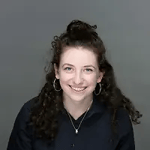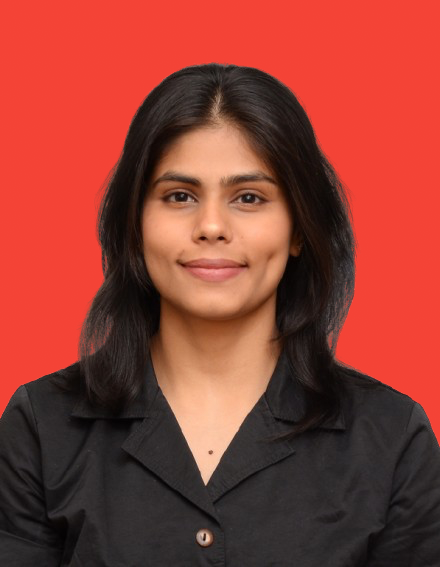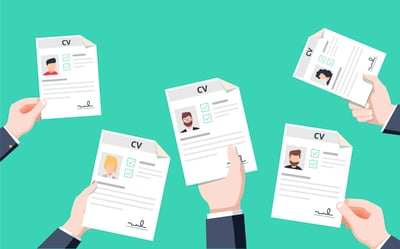June 18, 2019
 by Daniella Alscher / June 18, 2019
by Daniella Alscher / June 18, 2019

You’ve slaved away for years studying, scaling, aligning, kerning, and saturating.
It’s probably time to get up off of the couch and start interviewing for a graphic design job.
You may have crafted the perfect graphic design resume, but no agency or company looking for an in-house designer is going to hire you without an interview.
An interview for your dream job as a graphic designer should be a breeze – you’re getting to talk about yourself and what you’re passionate about. But it doesn’t matter if you’ve just graduated college or if you’re making a career change; no matter your experience level, everybody gets nervous. Suddenly, we can’t remember what activities we participated in outside of class, how long we had that internship for, or where we worked before this interview.
Interviewers are usually pretty understanding. But freezing up is something that can be prevented with preparation. The following are some questions that you might be asked as you’re interviewing for a job as a graphic designer.
Interviewers have limited time to hear your answers. To keep yours concise, follow the STAR method: tell the interviewer about the SITUATION, the TASK you had to complete, the ACTION you took to complete the task, and the RESULTS you got.
While you could tell the interviewer how much you love dogs and quinoa, that’s not really what they’re wanting to hear.
What they do want to hear is more about what you’re good at, and how it relates to the job. Share the amount of experience you’ve had as a designer, recent projects that have been successful, and what you’ve been up to lately.
Here’s a sample answer to get the ball rolling:
I attended ___ University and graduated in ___ with a degree in ____. Since then, I’ve been doing freelance work for a local cafe that was rebranding while working for them part-time as a waiter. I’ve helped them out with their website design, their updated logo, and a reworking of their menu layout. I’ve really enjoyed working with them consistently because although it’s within the same business, I’m getting to work on a few different things at the same time and see my impact make a real difference for them.
If the interviewer asks what the restaurant serves, that’s when you can talk about quinoa.
Some graphic designers are generalists. They can do a little layout, play with typography a bit, and have a basic understanding of color theory. Other graphic designers particularly enjoy or specialize in a particular area. If you specialize in typography, say so. Usually, we’d say that there’s no right answer to this question, and there isn’t. But there are answers that are more right than others.
You should know the job description for this interview like the back of your hand.
If the posting says that this company is specifically looking for a web designer and you’re much more interested in typography, it’s probably best to not apply for that job in the first place. If you decide to apply and you get the interview, make yourself and your interests relevant to that job.
Positivity is an enormous part of interviewing. If you can spin your lack of excitement for one subject into enthusiasm, do it.
For example, you can tell the interviewer that, although you don’t have much experience with web design, you’re a fast and eager learner and that you specialize in typography so that part of the process shouldn’t be an issue to go over with you.
When an interviewer asks this question, they likely have a preferred software that they use throughout the company in mind and are trying to find out if you’ve used it before.
Do some research and see if you can learn what software they use ahead of time; sometimes the job description will specify what you need to be familiar with. If it’s proving difficult to find out what kind of software this company uses, simply be honest and tell the interviewer what software you do have experience with. There’s nothing worse than a candidate lying about something as monumental as software knowledge.
If you don’t have a lot of experience with expensive graphic design software, express your willingness to learn more about it. If you’ve had to learn new software programs on the job at a previous job or internship, mention it in your answer. This shows that you’re at least capable of taking on a challenge like this.
Not all graphic design software is expensive. There are some free graphic design software options that you can begin to read about and test out on your own. This way, you’ll have experience with some type of software in your back pocket, even if it’s not the one that the interviewing company uses.
Now that the interviewer has heard a little bit about your successes, they’re going to want you to sneak a couple flaws you’re able to recognize about yourself into the mix. The ability to acknowledge shortcomings doesn’t mean you’re not fit for the job. In fact, it could mean the opposite; it shows that you’re self-aware, which is a great quality in an employee.
When discussing your strengths, make sure you have some examples lined up. Don’t just say, “one of my strengths is that I’m open-minded”. Take statements like those a step further by providing situations in which you’ve been able to use that trait to not only your advantage, but to the benefit of the entire team.
One of my strengths is that I’m an open-minded designer. I find that I’m able to acknowledge that sometimes, my ideas can be good, but they might not always be the best. I am constantly implementing the suggestions of others and sometimes finding that without those suggestions, the result wouldn’t have been as successful.
When discussing a weakness, make it clear (and be honest) that you’re working towards resolving it.
I’ve been called a perfectionist in the past because I had a tendency to linger on projects until I felt that they were up to my standards, to the point that I would sometimes push the deadlines. Since then, I’ve successfully worked to remind myself of the importance in the balance between perfection and timeliness.
This is a must-have for interviews. While other job interviews involve more of a tell than a show kind of process, graphic design interviews are absolutely show and tell.
| Oops! You don’t have one? Let’s backtrack and read a little bit about how to design a graphic design portfolio from the ground up. |
Be prepared to explain each and every decision you made in your portfolio, from your application of color contrast to the reason you went with sans serif font instead of serif.
In your portfolio, make sure that you detail timeframes and exactly what you contributed to each project.
There are a variety of questions interviewers could ask you about your portfolio and the projects within it:
Did you come across any challenges while designing this portfolio? How did you overcome them?
Why did you choose this color palette for your portfolio?
What was the result of this piece you designed?
Don’t be scared. Your interviewer is asking these questions to see what your role has been in past projects and to see if you’re a logical and strategic thinker when it comes to making decisions about your design. Study your own portfolio well before the interview to make sure that you can answer all of these questions confidently.
Most graphic designers will spend the majority of their day working on their own. That doesn’t mean there will be no outside contact. Interviewers are asking this question to make sure that you’re able to be flexible and work well with coworkers and customers. For example, if you’re interviewing for a job in packaging design, you’ll likely have to communicate with the sales team, product developers, and clients.
Again, answer honestly. If you strongly prefer working alone, bring up something positive that you see about working in a collaborative environment, and vice versa.
I prefer working collaboratively with other designers, but I’ve also found that it’s easier for me to hit my deadlines when I work alone.
The way that you take criticism shows the interviewer how open-minded you are about viewing your work in a different way. It’s important that you know how to respond to negative feedback in a neutral way, at the very least. Let the interviewer know that you’re always interested to hear what clients have to say, that you have an appreciation for any and all feedback, and that you’re able to take any new suggestions into account.
Flexibility is a huge part of being a graphic designer, and your response to criticism lets the interviewer know how flexible you really are.
It happens to all of us. We think too hard, we can’t remember what the color purple looks like, and our brains shut down. Sometimes, waiting that brain block out isn’t an option. At a job, deadlines apply, and nobody is going to care if you’re having a brain fart.
Tell the interviewer of any techniques you have to overcome a creative block; it could be taking a quick walk outside, working through a mind map, or playing with LEGOs. Explain how that technique works for you and what your thought process looks like during it.
Whatever your remedy is, be sure you have an answer prepared. No need to experience a creative block while you’re in the interview.
| TIP: This is an example of a behavioral interview question. Always be prepared for a potential curveball like this one during an interview. |
That beautiful portfolio you designed isn’t enough to prove to an interviewer that you have what it takes to blow them away with your talent, but showing up prepared to an interview ready to answer any question you fire is sure to impress.
You have a great resume and you’re prepared to answer these questions. Why not add a graphic design cover letter to the mix?
Daniella Alscher is a Brand Designer for G2. When she's not reading or writing, she's spending time with her dog, watching a true crime documentary on Netflix, or trying to learn something completely new. (she/her/hers)
As a recruiter or hiring manager, you probably spend hours crafting thoughtful questions to...
 by Yashwathy Marudhachalam
by Yashwathy Marudhachalam
There’s no doubt about it: graphic designer’s resumes can look awesome.
 by Daniella Alscher
by Daniella Alscher
You’ve just landed a phone interview—congratulations!
 by Derek Doeing
by Derek Doeing
As a recruiter or hiring manager, you probably spend hours crafting thoughtful questions to...
 by Yashwathy Marudhachalam
by Yashwathy Marudhachalam
There’s no doubt about it: graphic designer’s resumes can look awesome.
 by Daniella Alscher
by Daniella Alscher


